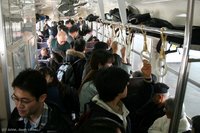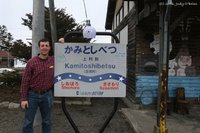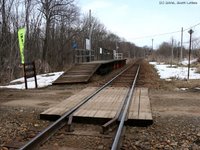 Hokkaido will lose 140 kilometers of railway this month. On April 20th, the Hokkaido Chihoku Highland Railway will make its last runs, ending 95 years of rail service to many rural communities, small towns and agricultural valleys of eastern Hokkaido.
Hokkaido will lose 140 kilometers of railway this month. On April 20th, the Hokkaido Chihoku Highland Railway will make its last runs, ending 95 years of rail service to many rural communities, small towns and agricultural valleys of eastern Hokkaido. The north-south oriented line was completed in 1911, making it among Hokkaido’s first railways. At the time it was a mainline linking Ikeda, a city near the Pacific coast, with Abashiri, across the island on the Sea of Okhotsk. Twenty-one years later, in 1932, a new, more direct line was completed between Abashiri and the more populous western part of Hokkaido. That leads me to believe that the Chihoku line between Ikeda and Kitami lost a great deal of its importance as a trunk line. It retained, however, significant importance as a feeder route, serving rich timber- and farmlands. Signs outside the town of Honbetsu proclaim it to be Japan’s number one bean producer. There’s even a small shrine dedicated to that crop beside one of the railway stations.
With time, however, the freight business either dried up or shifted to trucks, leaving only the patronage of a small population base to support the railway. In 1989, JR Hokkaido sold off the Chihoku line, creating the Hokkaido Chihoku Highland Railway. The new operator took significant measures to improve service and cut financial losses, immediately increasing train frequency by 40%, while acquiring newer, more cost effective equipment and further reducing operating costs by eliminating on-board conductors. The operator also brought the line a facelift, adopting the “Galaxy Railway” nickname and decorating its stations in stars and Zodiac signs, while applying festive, cartoon paintschemes to some of its trains. Service continued to improve, including a daily express that cut travel time between Kitami and Ikeda by over 45 minutes and provided direct service across JR tracks to Obihiro.
Improved service and image can only go so far, though. The fact remains that the Chihoku line traverses very sparsely populated countryside. There is a Japanese website ranking the 200 most remote, off-the-beaten-path railway stations (hikyoh eki) in the country. Of the 33 stations on the Chihoku Line, eight make the list, including four that rank in the top 30.
Ridership remained low. In 1998, the line averaged only 361 passengers per day per kilometer, ranking it last out of all rural lines in the country. By contrast, JR Hokkaido’s target for rural lines is 2000 passengers per day per kilometer. Operating expenses in 1998 on the Chihoku Line exceeded revenues by nearly 500 million yen. (Source: “Railway Operators in Japan 2,” by Shuichi Takashima, Japan Railway and Transport Review, September 2001.) Despite strong support from the communities it serves, including over 160 high school students who ride it every school day, the Chihoku Line announced its closure last March.
Since learning of the line’s imminent demise two months ago, I had been plotting ways of getting there. When I found out that Maureen’s musical rehearsal in April was only half an hour from the line, I had my chance. I contacted Dustin, an American teacher in Muroran who has admitted a certain interest in Japanese railways. I’m working to further corrupt him, and thought this to be an excellent opportunity. He had an office party on Friday evening, but was free for the rest of the weekend. “Do you mind leaving really early on Saturday?” I asked. He didn’t mind at all. He even convinced Judy, a British teacher also in Muroran, to tag along.
 At 3:45am on Saturday, the three of us were abruptly roused by all three of Dustin’s well-synchronized alarm clocks going off at exactly the same time. We were pulling out of the driveway within 25 minutes, and were only a little disturbed to see a man out walking his dog at that hour. A fabulous sunrise on the highway near Tomakomai gave us all a good feeling about the trip.
At 3:45am on Saturday, the three of us were abruptly roused by all three of Dustin’s well-synchronized alarm clocks going off at exactly the same time. We were pulling out of the driveway within 25 minutes, and were only a little disturbed to see a man out walking his dog at that hour. A fabulous sunrise on the highway near Tomakomai gave us all a good feeling about the trip.There seems to be a certain Japanese – or, perhaps human – fascination with closures, abandonments, last runs, and all layings to rest of the works of men. The station agent at Ikeda, the southern terminus of the Chihoku Line, opened the train for boarding half an hour prior to the scheduled 9:55 departure, a full twenty minutes earlier than usual. On this line that has ranked dead last in ridership nationwide for so many years, we could only find two seats open seats. Fifteen minutes before departure, it was standing room only. And still more passengers kept coming.
 “You’d think they’d add another car,” Dustin said of the one-car train.
“You’d think they’d add another car,” Dustin said of the one-car train.“It might be that they don’t have another car to add,” I replied.
The train pulled out right on time and began its three-hour run through the countryside. We stopped at nearly every station, the facilities ranging from forlorn wooden platforms without a building in site to modern, multi-story buildings that double as community centers in the towns they serve. The promotional literature on hand was quick to point out such good citizenship, but we could find nothing regarding whether the stations could remain opened without the support of the railway.
There were few if any passengers getting on or off at most stops, but nearly every platform had at least one photographer documenting the moment. Some had several. Midway through the run, Judy was shocked to notice that one man in a small, white SUV seemed to be following us, taking photos at one location then racing ahead of the train to another spot.
“Do you suppose he’ll follow us all the way to Kitami?” Judy asked in disbelief.
“And probably all the way back, too,” I returned.
“Is he crazy?” she quipped. “Who, in their right mind, goes flying around following a train all day?”
“Well, me, for one, if I had a car,” I replied without the sheepishness that usually accompanies such a response. For once, my way of thinking was the majority.
Returning on the southbound train that afternoon, we managed to secure three seats together by rushing the platform the moment boarding was announced. The train was just as full, if not a little more so, and we found a middle-aged Japanese man standing in the aisle beside us. He introduced himself, in very good English, as Go Yukawa and struck up a conversation.
“Where are you from?” we asked him.
“Yokohama, near Tokyo.”
“You came all the way from Yokohama just to ride this train?” Judy’s mouth stood agape.
“You still don’t get it, do you?” I chided her.
“Well, I think I’m beginning to get it, but it still astonishes me.”
Returning to our Japanese friend, I asked, “How long are you staying here?”
“I flew up from Tokyo this morning. I fly home tonight.”
“You must like trains!” Even I had trouble hiding my shock over that.
“Yes,” he agreed. “And you?”
“Oh yes, very much.”
“I was hoping to take lots of photos today,” he said, pointing to my camera, “but it is too crowded. I come here to memorize this run, memorize this railway…but all I memorize is too many people.”
At the end of the run, back at Ikeda, we rushed to the front of the train with Yukawa-san to take photos in the four minutes before his connecting train left for Obihiro. We lingered for a bit in the sunset light after most of the other passengers had left, and drove a bit north into the countryside to watch the next northbound roll off into the fading light and explore Samamai, the first station north of Ikeda and number 72 on the hikyoh eki list.
“Obihiro is well-known for their butadon,” Dustin told us as we entered the city.
“What’s that?” I asked.
“Grilled pork over rice. It’s very good.”
“That sounds great to me. I’d love to find an out-of-the-way, local place to eat dinner.”
“Hey! I think that place right there had a sign for butadon,” he exclaimed, pointing over his right shoulder.
I couldn’t see anything even resembling a restaurant, but he turned around and pulled into a wooden shack with a small sign out front. Inside, we found a single table and a small bar in front of the kitchen area, which appeared to be in front of the owners’ living quarters. A smiling, wrinkled woman brought us steaming bowls of grilled pork over rice in a sauce that was delicious beyond words. She gave us tea and miso soup free of charge, then took our photo with a small Polaroid camera, which she added to her guestbook that Dustin signed for all three of us (the joke at Dustin’s school is that his Japanese is better than all the Japanese teachers in the English department – and it’s only a half-joke).
We followed a steaming creek up to an onsen where we soaked with a night view of Obihiro, then enjoyed free lodging generously provided by Maureen’s musical group. We also had Sunday morning free while the performers rehearsed. I was thinking of how I’d like to return to the railway and take some more photos, but decided I’d better not push Dustin and especially Judy too far.
As we piled into his car, he turned and asked what we wanted to do.
“You’re driving,” I told him.
“I’m just along for the ride,” Judy added.
“Well, I was thinking I might like to go back and get some photos of the stations on the railway.”
“That sounds fine to me!” I replied, trying unsuccessfully to conceal my enthusiasm.
“I’ve come this far with you crazy guys,” Judy said. “I might as well get the full experience.”
 After visiting several of the nearby stations and even photographing a pair of trains, we found ourselves at the Ashoro station wondering where to go next. There was time to explore Obihiro, or time to explore more of the railway, but not time to do both.
After visiting several of the nearby stations and even photographing a pair of trains, we found ourselves at the Ashoro station wondering where to go next. There was time to explore Obihiro, or time to explore more of the railway, but not time to do both. “Do you want to find your station?” Dustin asked.
As part of the Galaxy theme, the railway has labeled certain stations with the twelve signs of the Zodiac. Despite the crowds, I had managed to snap photos of the signs at Dustin’s and Judy’s stations on the previous day, but had missed my own.
“It’s a quite bit further north,” I replied. “We don’t have to find it. I just want to buy a key chain here, and you guys can decide where we’re going next.”
Judy was the first to speak when I returned from making my purchase.
“We’ve been talking,” she told me, very matter-of-factly, “and we’ve decided that we need to go find your station.”
I beamed. “I love you guys!”
My station, Aeries, was Kamitoshibetsu, a log structure in a sawmill town where an old siding once used to load lumber onto flatcars now rusted in the weeds between the station and the mill. I couldn’t have been happier.


There was another hikyoh eki nearby, and Dustin endeavored to find it. Along the way, we crossed a stream on a road bridge parallel to a bridge on the railway. Looking at the railway bridge, Judy exclaimed, “Oh, that would be a nice shot, right there!”
I glanced at the timetable but said nothing.
 Dustin found Sasamori station, number 30 on the list, near the end of a dirt road with absolutely nothing else around. It is served by nine trains daily, five one way and four the other, and none of us could figure out why.
Dustin found Sasamori station, number 30 on the list, near the end of a dirt road with absolutely nothing else around. It is served by nine trains daily, five one way and four the other, and none of us could figure out why. Looking at the schedule posted on the simple wooden platform, I remarked, “There’s a northbound coming soon.”
Dustin glanced at his watch. “We probably should start heading back.”
“C’mon! It’s only twelve minutes.”
Dustin looked at Judy.
“Let’s get the man his shot!” she returned. “You’ll share the photo, won’t you?”
“Absolutely!”
“Okay,” Dustin agreed. “Where do you want it?”
“Either here or back at that bridge.”
 “Oh, the bridge is a better shot.” Judy made the decision.
“Oh, the bridge is a better shot.” Judy made the decision.As the single car rolled across the bridge and into history, I wished that Yukawa-san could have been with us. Not on the crowded trains, but out here in the towns and countryside along the line, did I fix my memories of the Chihoku Line.
We returned to the musical rehearsal just in time for me to get some photos of the cast teaching one of their dances to several local kids, and thereby earn at least a little of our free lodging from the night before. When they were finished, we found Maureen, loaded her and her stuff into the car with us and all of our stuff, and chased the setting sun back towards Muroran.
“So where are we going for our next trip?” Dustin asked me on the drive home.
“Well, I’ve been thinking of riding length of the Hidaka line sometime.”
“Oh, that would be nice!”
“Where’s that?” Judy asked tentatively.

“It runs southeast from Tomakomai right along the coast. Ocean on one side, horse farms on the other.”
“I can’t believe I’m saying this,” she began, “but let me know when you’re going. I just might want to tag along.”
5 comments:
Hey Scott,
Awesome write-up. You continue to amaze. I hope I can write a post that's half as good as this when I finally get around to it.
Oh, and Happy Birthday yesterday. Good times.
Really enjoyed this piece, hope to get down to Muroran to meet you sometime in May.
hi, Scott.
I'm like you were in your first 2 years of high school. Thanks for the tips. I think I'm going to join golf or drama. I have physical problems that don't allow me to do much. I would greatly appreciate any extra suggestions you would have for me. & maybe one day I can be an English teacher in some far off place. -ty
hi, Scott.
I'm like you were in your first 2 years of high school. Thanks for the tips. I think I'm going to join golf or drama. I have physical problems that don't allow me to do much. I would greatly appreciate any extra suggestions you would have for me. & maybe one day I can be an English teacher in some far off place. -ty
hi scott,
danke schrön. Thank you very much for your advice. Unfortunately, my medical problems are currently keeping me from leaving the country for any length of time right now. However, I am signed up for the school's next trip to Germany in the Summer of 2008. I applied for a job with the Billings Mustangs this summer & will talk to someone about working for the school newspaper Monday. I'll keep you posted on what happens.
How did you know of the Mustangs? From Montana?
danke schrön. -Marco
Post a Comment